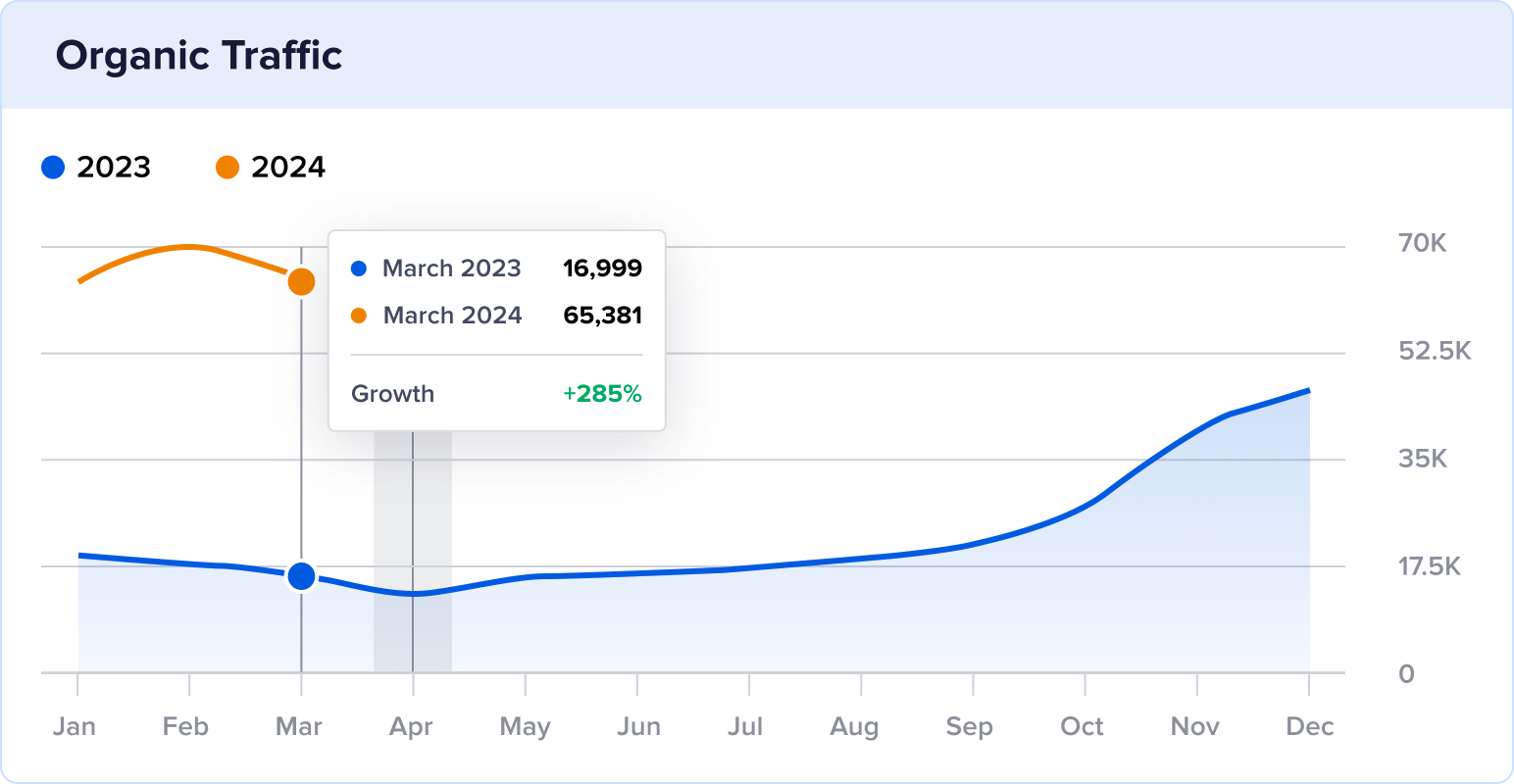How a Travel & Tourism Site Quadrupled Traffic in 10 Months
https://www.explore.com/
Stats
67.6K to 212K Monthly Visits
Industry
Travel & Tourism
Niche
Travel Guide
Reporting Date
September 2023
Tourism is one of the top 10 global industries by revenue.
However, as one of the most lucrative sectors, it’s also among the most challenging to rank for in search engine results.
So, how did one travel and tourism website break a 5+ year standstill and reach 305% organic growth in less than a year?
You’re about to find out.
In this case study, we’ll share how explore.com navigated one of the most competitive markets to come out on top—one search result at a time.
Let’s dive in.
In This Article
About Explore
Explore is a comprehensive travel platform for every step of the trip-planning process.
It provides destination recommendations, travel guides, packing tips, and more.
Just shy of bookings, Explore.com has everything a traveler needs to inspire, choose, and organize their next trip.
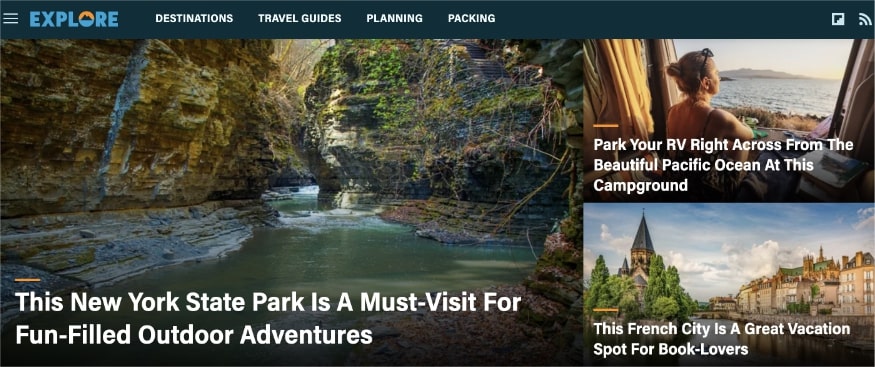
Historical Performance
According to site captures from the Wayback Machine, the domain goes back to 1997.
During its lifetime, the website has seen several changes in ownership and intent.
For this case study, we’ll focus on its most recent stint as a travel and tourism website starting at the end of 2017.
During this time, Explore was a South Pacific-based online travel agency.
It offered accommodation deals for the region and partnered with local businesses to promote tourism.
Here is a screen capture of the website’s homepage in 2021:
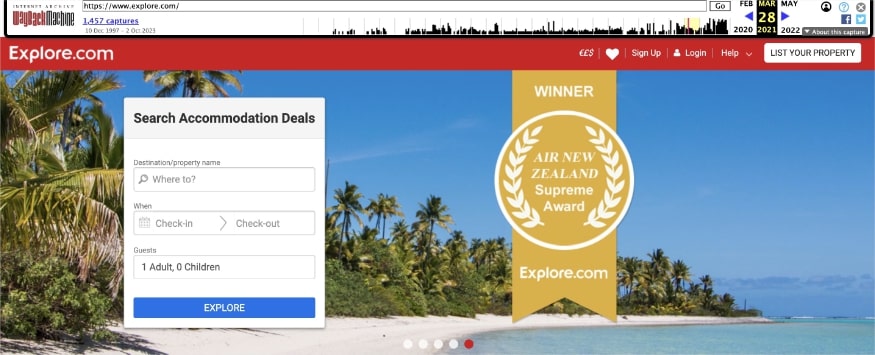
Unfortunately, the website never really took off.
Semrush historical data reveals the following metrics:

And when we look at the all-time growth chart, these numbers don’t even register compared to today’s performance.
That is, until November 2022, when we see a spike in traffic.
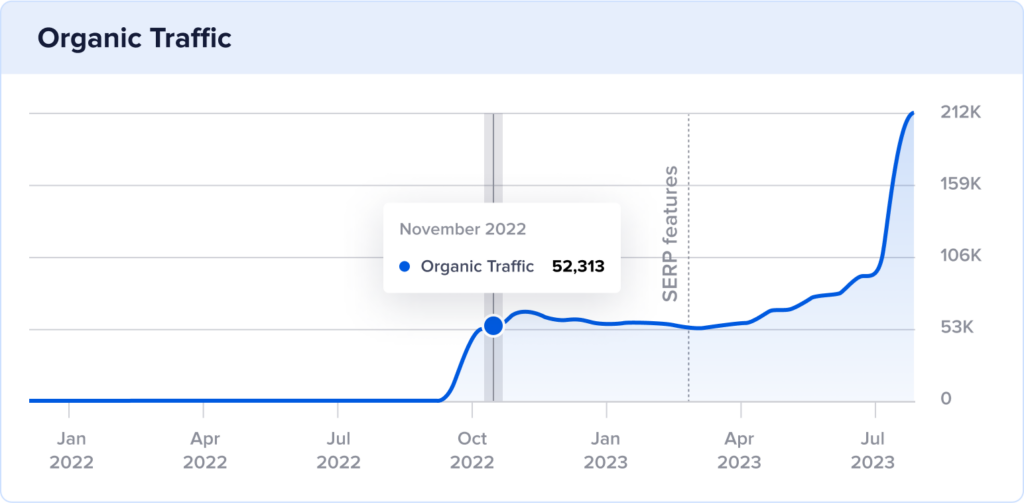
So, what happened to explode organic traffic from 172 visits to 52K in under a month?
Turns out, there was a change of ownership.
In November 2022, Static Media acquired explore.com.

This internet publishing company owns 17 other brands, with Explore as its sole travel venture.
They didn’t waste any time rebranding the site to the state of Explore we know today.
But what exactly did they do (besides a redesign) to catapult this sleepy domain to unprecedented heights?
We’re going to give you all the details next.
The Catalyst: How Explore Achieved 305% Growth in 10 Months
Explore.com grew its organic traffic by performing the following:
- Targeting long-tail keywords
- Implementing schema markup
- Obtaining high-quality backlinks
Let’s look at each of these items in detail to understand their significance and what impact they had on Explore’s growth.
1. Targeting Long-Tail Keywords
After acquiring explore.com, Static Media got to work on what it does best: content creation.
A before and after comparison illustrates the transformation:
- Before Acquisition (October 2022): 239 pages, 72 visits
- After Acquisition (November 2022): 2,432 pages, 52K visits
This push to grow its content offering continues today, with September boasting 5,054 pages.
When we look at Explore’s top traffic-driving pages, it’s clear that they’re targeting long-tail keywords. These pages have a very specific purpose and search intent to fill.
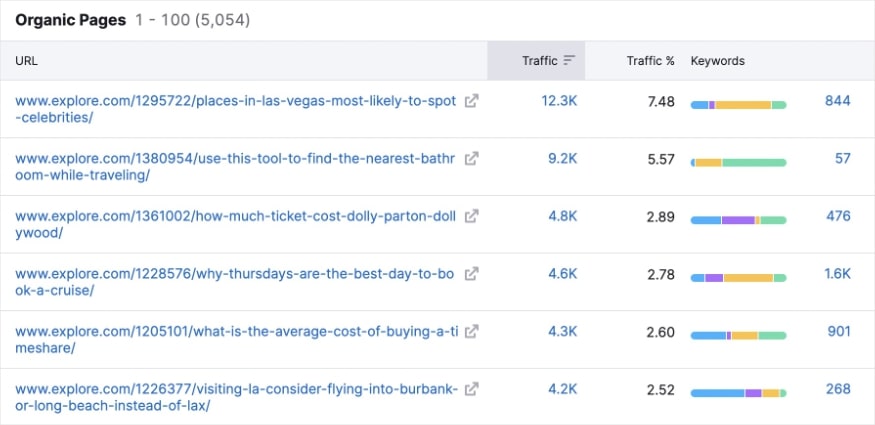
Long-tail keywords are longer search queries when people seek something specific. They’re typically a combination of 3 or more words.
Let’s look at the top page’s ranking keywords for a demonstration.
Places in Las Vegas Where You’re Most Likely to Spot Celebrities currently ranks in position 1 for the following long-tail keywords:
- where do celebrities stay in vegas
- celebrities in las vegas
- celebrities in las vegas today
The article lists 15 places where the public has the best chance of spotting their favorite celebrity.
It’s direct, answers the search query, and doesn’t leave the reader wondering where to go.
Here’s another example: This Visiting LA blog presents two alternatives to LAX and details the benefits of each airport. Readers can then decide which one meets their needs.
This blog currently ranks in the top 5 for the following keywords:
- burbank vs lax
- burbank airport vs lax
- long beach airport vs lax
Why this matters:
Long-tail keywords are easier to rank for because they have less competition than short-tail keywords. They also have a higher conversion rate (CR). This combination of low competition + high CR makes long-tail keywords extremely valuable ranking opportunities.
How to find long-tail keywords for your site:
There are several ways to find long-tail keywords manually. This guide explains three methods for doing so.
One quick, free, and easy way is by performing a Google search. Start by typing your keyword (don’t hit enter) and see what Google populates for search suggestions.
Here’s an example of long-tail keywords generated from the search “blog ideas”:

Tools for finding long-tail keywords:
If you have a WordPress site, finding long-tail keywords is easy with All in One SEO (AIOSEO).
After setting the focus keyphrase for your page or post, click Additional Keyphrases. AIOSEO will fetch relevant terms from Semrush for you, many of which will be long-tail results.
Here’s an example of the keywords it obtained for “patio furniture”:

You can then Add Keyphrase and TruSEO will analyze your optimizations for it. It’s as simple as that.
For a step-by-step tutorial on how to perform this process, follow this link.
Next, we’ll look at how Explore uses schema markup to drive more traffic to its website.
2. Implementing Schema Markup
With over 5K new pages on the site, Explore applied technical SEO best practices to get its content on the search engine results page (SERP).
Schema markup, or structured data, is specialized code within a web page. It communicates to search engines the content of your page.
It’s also a key factor in getting rich snippets on the SERP.
Rich snippets are enhanced search results that show more information directly on the SERP.
Here is an example of a rich result for the search query “best dog parks”:

While analyzing explore.com, we encountered several schema types, including, but not limited to:
- Article
- Author
- Brand
- Breadcrumb
- Image
- Organization
Why this matters:
By including schema markup in its code, Explore effectively wins more rich results on the SERP. These enhanced search results gain more user attention, boost clickthrough rates (CTR), and drive traffic to the site. A powerful combination for websites looking to grow their online visibility.
How to implement schema markup on your site:
There are several ways to enter structured data on your site manually.
This article shows three ways of adding schema markup to WordPress without a plugin.
Each method involves a few steps to obtain and copy code snippets into the appropriate fields.
Tools for implementing schema markup:
Working with code can be intimidating, but the good news is that a WordPress SEO plugin can do the work for you. AIOSEO’s Schema Generator makes it easier than ever to use structured data on your site. Our ever-growing catalog of schema types allows you to pick the one you want; then we’ll take care of the rest.
Here are the schema types available in AIOSEO:

Now, we’ll look at the final contributing factor to Explore’s explosive growth: backlinks.
3. Obtaining High-Quality Backlinks
As we recall from Explore’s organic growth chart, a second traffic spike emerged in September.
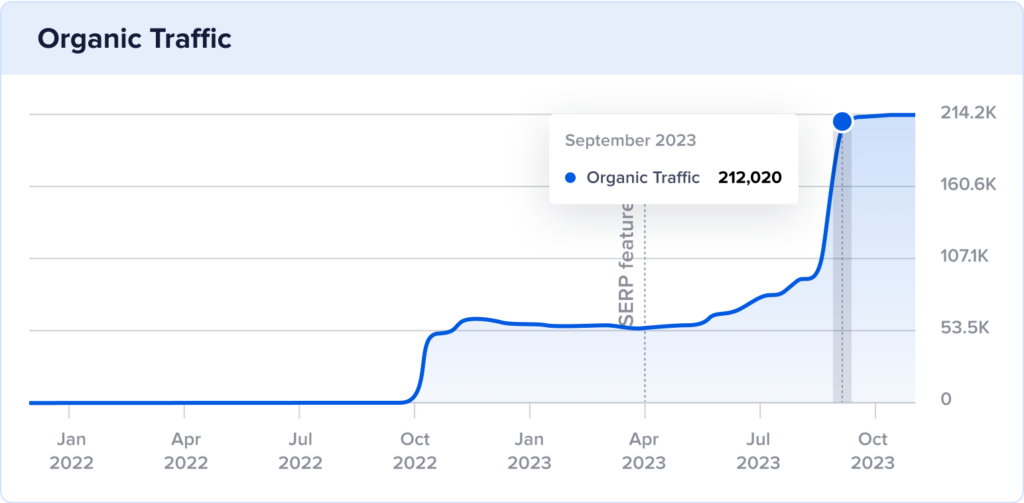
This surge can be attributed to two key factors: the continued release of new content (which we addressed earlier) and an influx of authoritative backlinks.
Explore’s summer season proved fruitful for their backlinking efforts.
May marks the beginning of growth, with September reaching 291K backlinks.

When reviewing Explore’s backlink profile, 2023 revealed 19 new backlinks with an Authority Score (AS) of 80 or above.
Note: Authority Score is a Semrush metric for measuring a domain’s overall quality and performance. You may also see this metric as Domain Authority (DA).
Turns out, these backlinks come from Static Media and its 17 other brands.
This Explore footer shows all the Static Media sites. These are the same sites backlinking to explore.com. (It also means explore.com is externally linking to other Static Media sites.)

Each Static Media site uses these footers to link across brands.
This reciprocal linking strategy enhances Static Media’s SEO for all its websites.
Why this matters:
By joining the network of other high-authority websites, Explore has gained the trust of search engines in a short amount of time. It’s also cementing itself as a credible and authoritative source in the travel industry.
This backlinking strategy serves as a valuable lesson for businesses with multiple websites. It showcases the effectiveness of interlinking across brands and how it can help improve the ranking of your newest website.
How to do link building on your site:
A comprehensive SEO strategy goes beyond backlinks. Every effective linking strategy should optimize for the following types of links:
- Internal links (from one page on your site to another page on your site)
- Outbound links (from your site to another external site)
- Backlinks (from an external site to your site)
This link-building guide has all the steps to optimize for each.
Ultimately, the first priority of link building is to produce high-quality, valuable content. People will naturally want to link to content they find helpful. Then, as you’re actively link building, aim for quality over quantity.
As demonstrated by Explore, a handful of high AS backlinks are worth more than thousands of low-quality ones.
Tools for link building:
Link Assistant can help you identify internal linking opportunities without scouring your site. When you’re working in the WordPress editor, Link Assistant presents linking suggestions just below your content. Simply click Add Link, and you’re set.
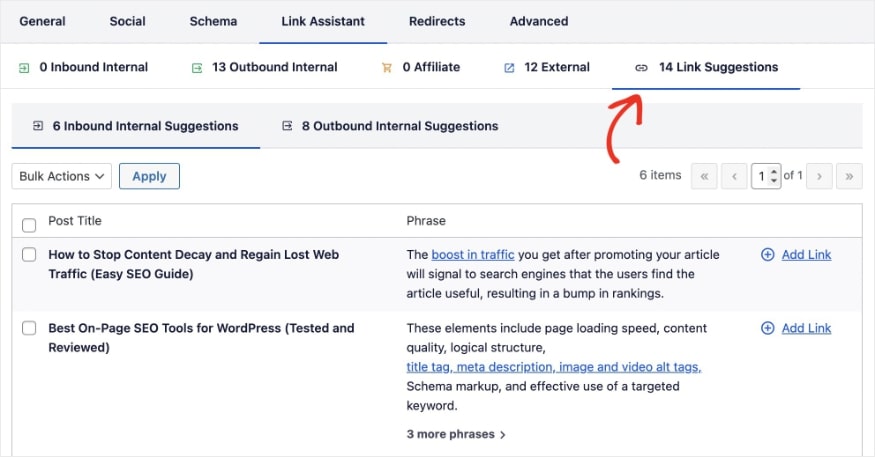
For WordPress multisite networks, AIOSEO can also help you manage all your websites seamlessly.
The Robots.txt Editor allows you to edit the robots.txt file of every domain individually or in a batch.
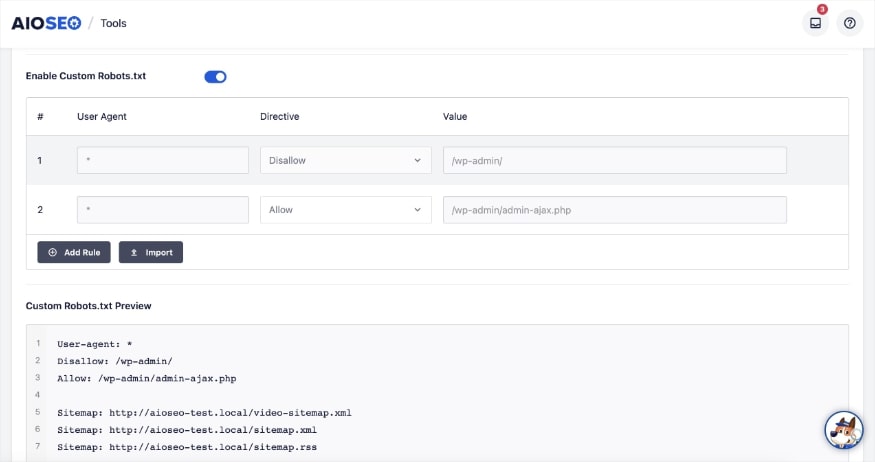
To learn more, this multisite SEO guide shows how to set up your network correctly.
Standout SEO Wins
Before we conclude, there is an additional SEO technique we’d like to highlight from explore.com:
1. They have a search-friendly infinite scroll.
Not only is Explore creating user-centric content that fulfills search intent, but they’re also keeping readers on the site with infinite scrolling capabilities.
This design choice can reduce bounce rate, as new content automatically loads and users stay on the website longer.
The caveat?
Infinite scrolling requires proper setup to be search-engine-friendly. When done incorrectly, this feature can make it challenging for bots to crawl and index.
Ultimately, this can have unintentional consequences on your website’s SEO.
Now, in Explore’s case, they implemented it correctly.
While the user experience is visually an infinite scroll, the site treats content as traditional, unique pages.
Here’s how:
- Each page has a unique URL.
- Each page uses a self-referencing canonical tag.
- Scrolling to the bottom of a page automatically updates the URL.
Ultimately, Explore’s infinite scroll creates a win-win experience for users and crawlers. It ensures valuable content is legible to both, ensuring discoverability and SEO performance.
Note: Infinite scroll is notoriously challenging for SEO. If you want to offer this feature on your WordPress site, you’ll want to do the proper research before selecting a plugin to implement it. Generally, it is advised to use traditional pagination (separate content into pages) for the best crawlability and SEO performance.
Tool: Whether you opt for pagination or infinite scroll, AIOSEO can help you manage canonical URLs for proper indexing and ranking. Canonical tags help search engines understand which page to serve when you have similar content. You can customize canonical URLs for every page of your site or leave them as self-referencing, which is their default setting.

Takeaways
In our analysis of Explore’s growth story, we’ve uncovered the strategies that contributed to its explosive success.
Now, let’s review which tactics to use on your website and which ones to reconsider.
Top 3 Strategies to Emulate
- Target long-tail keywords and create content that fulfills search intent. Explore focuses on longer queries that have a hyper-focused intent. It then crafts content to answer the users’ specific needs.
- Implement schema markup to win more real estate on the SERP. Even though schema markup doesn’t guarantee a rich result, it increases your chances. By using structured data in your code, your site can win attention-grabbing results that drive more traffic.
- Build more backlinks and interlink across domains. Explore interlinks with other Static Media websites, creating a beneficial network of high-DA backlinks. This strategy boosts Explore’s credibility and trust with search engines and users.
Bottom 3 Strategies to Reconsider
- Overlooking FAQ schema. Even though Explore implements several schema types, it is not currently using FAQ schema. This omission doesn’t align with the site’s SERP trends, which are serving Explore for many question-based queries. A simple fix would be to include FAQ schema with the help of a schema generator.
- Missing easy metadata wins. Some meta titles and meta descriptions exceed optimal character limits. This translates to a truncated search result on the SERP. To avoid this issue, a SERP snippet preview can help you verify character lengths before publishing. You can also use an AI metadata generator to write them for you.
- Neglecting image title tags. Image SEO best practices call for alt text and title tags. And while Explore caters to the former, they’re missing out on the latter. AIOSEO has an image SEO feature that can populate image title tags automatically.
Steal Our SEO Winning Strategy: A Checklist for Your Website
Is your website facing the challenges of the fiercely competitive tourism industry? Or navigating another equally demanding sector?
Outranking the competition takes more than luck, so we’ve got you covered with our winning SEO checklist.
Consider it your action plan to dominate the SERP and boost your rankings.
Download A Free SEO Checklist
Access our comprehensive SEO Checklist with a single click. We’ll deliver it straight to you, putting actionable items with SEO tools and tutorials right at your fingertips.
Enter your name and email to download a free SEO checklist.
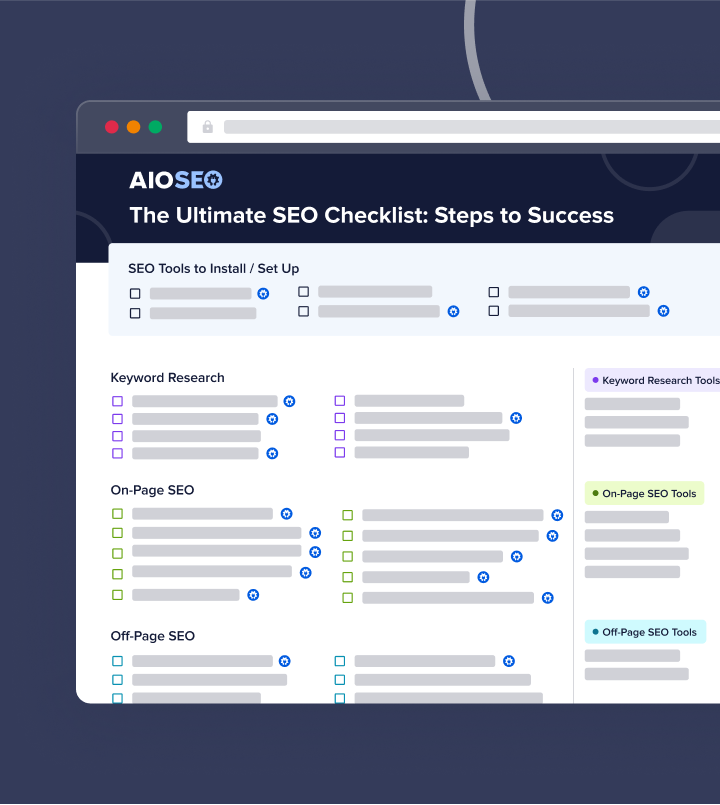
Outrank the Competition & Boost Traffic With AIOSEO
If your website struggles to stand out, know that you don’t have to take on the SERP alone.
All in One SEO provides the winning tools and support you need to outperform the competition.

Trusted as the best WordPress SEO plugin on the market, you’ll be in good company as you optimize your site. We make SEO easy, so you don’t have to learn the ins and outs (but don’t worry, there are advanced features if you want those, too!).
Here are some of our favorite features ready to launch your site’s visibility and rankings:
- Semrush Keyphrase Suggestions: Perform keyword research and find long-tail keywords without ever having to leave WordPress. AIOSEO connects with your Semrush account to pull keyphrase suggestions from its database and serve them to you in the WordPress editor.
- Schema Generator: Our comprehensive catalog allows you to pick and embed structured data without touching code. Websites with schema markup get more rich results on the SERP, a proven way to drive more traffic to your site.
- Link Assistant: Take a note from Explore and apply linking best practices that support content discovery. Link Assistant gives you easy linking suggestions and reports that keep your site free from orphan pages.
- Robots.txt Editor: Control how bots crawl your site with the Robots.txt Editor, which allows you to override default WordPress settings. This tool also makes it simple to manage rules across a multisite network.
- Network Feature Manager: Activate or deactivate add-ons across your network with the Network Feature Manager. You’ll streamline the updating process instead of toggling add-ons on/off for every site in your network.
- AI Title & Description Generator: Our newest feature revolutionizes how you write meta titles and descriptions. This game-changing tool uses AI to craft unique and compelling metadata for any page on your site.





